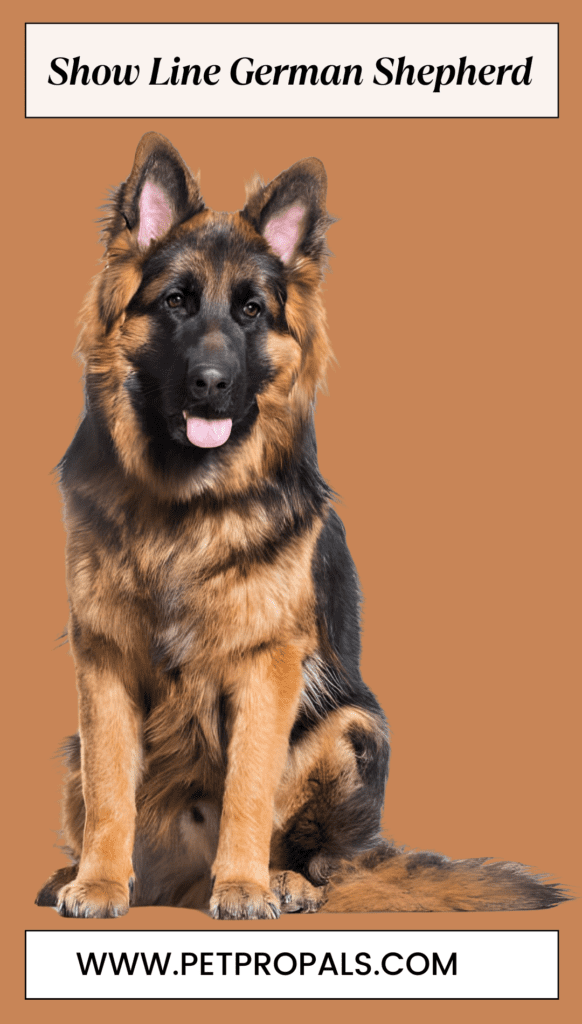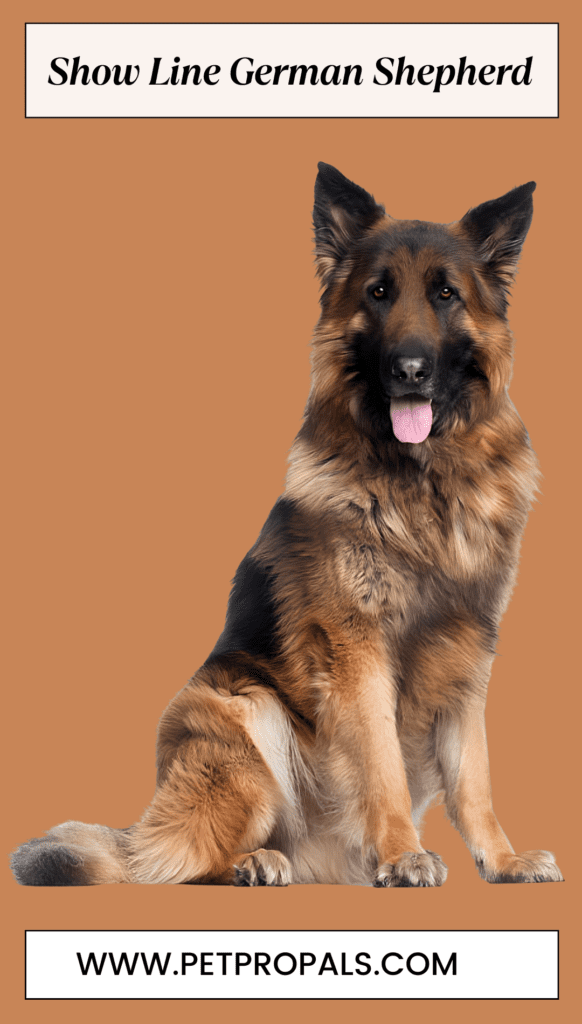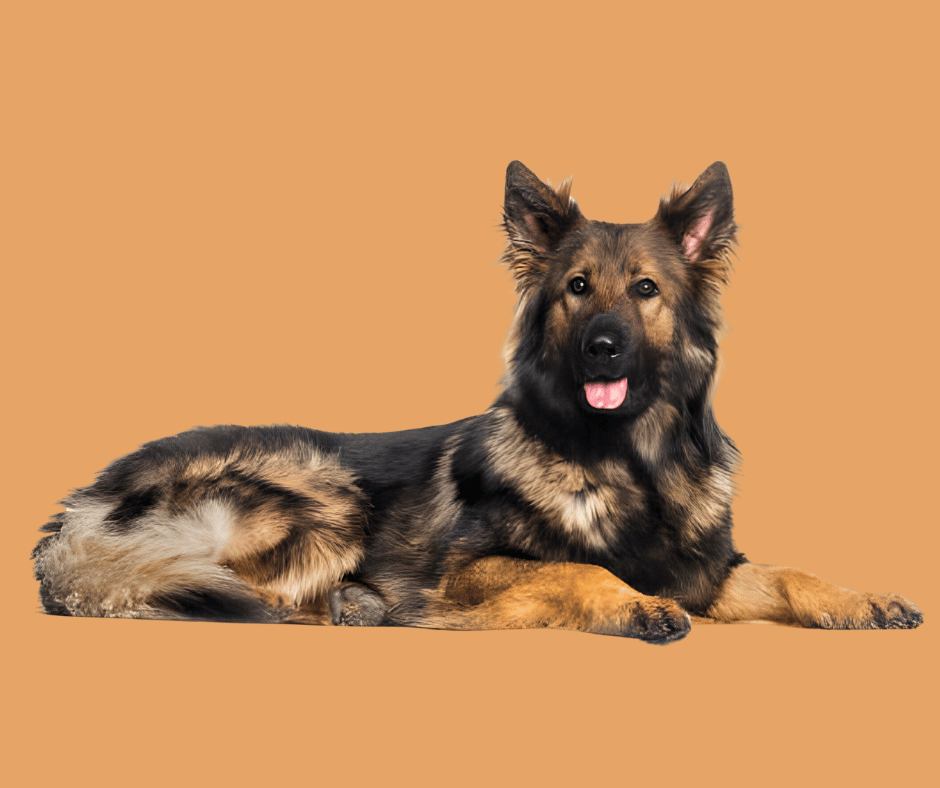Have you ever noticed how Show Line German Shepherds can look so different from one another?
Especially for those bred for exhibitions, they come in various sizes and forms.
Understanding The differences between German Show Line, West German Show Line, American Show Line, American-Canadian Show Line, and European Show Line (Czech, Slovak, etc.) helps us appreciate their unique traits and understand which type fits different roles, whether as a pet or a working companion.
This post will examine five different show-line German Shepherd breeds and discuss what makes each unique and how they vary.
Let’s explore the fantastic German Shepherds, whether you’re curious about owning one.
You Can Aslo Learn about Wroking Line German Shepherd by clicking this article link: Working Line German Shepherds: Lifespan, Cost, Care, Traits And More
What is Show Line German Shepherd?

The Showline German Shepherds represent a unique breed specifically designed for conformation shows.
Breeders meticulously select and breed these dogs to adhere to standards of appearance, movement, and temperament established by kennel clubs and breed organizations worldwide.
General Characteristics of Show Line German Shepherds:
Here are some detailed explanations of the General Characteristics of The Showline German Shepherds:
Appearance: Showline German Shepherds have a more pronounced back slope and straighter hind leg angulation, with a fuller coat for a noble appearance.
Temperament: They are known for their steady and calm temperament, crucial for withstanding the stress and scrutiny of show environments.
They are generally more predictable in behaviour and more accessible to handle in social settings.
Movement: Showline German Shepherds are bred for a smooth and flowing gait, showcasing effortless movement and agility in the show ring, evaluated based on the breed standard’s requirements.
Health: Responsible breeders prioritize good health and genetic diversity within the show line and work to minimize genetic conditions through careful breeding practices and health screening.
Read Also: Is a German Shepherd Rottweiler Mix Right for You? Read This First!
Purpose of Breeding for Show Lines German Shepherds
Breeding show line German Shepherds aims to produce excellent dogs in conformation shows by considering their physical attributes, movement, and temperament against a detailed breed standard.
This type of breeding also promotes the breed’s qualities as companion animals and potential working dogs in specialized fields, contributing to the preservation and improvement of the German Shepherd breed.
Types of Show Line German Shepherds

- German Show Line
- West German Show Line
- American Show Line
- American-Canadian Show Line
- European Show Line (Czech, Slovak, etc.)
There are several types of Show Line German Shepherds, each with unique characteristics and breeding standards.
These different types of Dogs my Including German Show Line, West German Show Line, American Show Line, American-Canadian Show Line, and European Show Line (Czech, Slovak, etc.) with specific differences in appearance, movement, and temperament.
Below, we are providing the details of each Type:
1. German Show Line
These German Shepherds come from Germany and are bred to meet the standards set by the German Shepherd Dog Club of Germany (SV).
They are known for their muscular and well-proportioned build, deep colour, and great movement. German Show Line Shepherds are often bred for their ability to work and succeed in the show ring.
Appearance
German Show Line German Shepherds are known for their well-proportioned build, strong bone structure, and deep chest.
They have a straight back that slopes gently towards their hindquarters.
Their coats have deep colours and clear markings, making them look regal in the show ring
Size and Weight
German Show Line German Shepherds are usually large dogs. Males are generally 24-26 inches (60-65 cm) tall at the shoulder, while females are slightly smaller at 22-24 inches (55-60 cm).
They generally weigh 65-90 pounds (30-40 kg). Males are usually heavier.
Behavior and Temperament
German Show Line Shepherds are known for being calm and confident. They are loyal and protective towards their families.
These dogs are intelligent and eager to please, making them easy to train and adaptable to different situations.
Diet and Nutrition
For these dogs, having a balanced diet with high-quality proteins and fats is essential.
Their food should match their energy needs, which depend on their activity level and age. It’s recommended to consult a vet for specific dietary advice.
Exercise Needs
German Show Line Shepherds require regular exercise to stay healthy and happy.
It is essential to keep them engaged with daily walks, playtime, and mental stimulation through training sessions.
Training Approaches
These dogs learn best with positive reinforcement training. Consistent training with clear rules helps them learn quickly.
Introducing them to people and other animals early is essential to help them develop properly.
Common Health Issues
German Show Line Shepherds are generally healthy but prone to hip dysplasia, elbow dysplasia, and degenerative myelopathy.
To prevent these issues, you must take your dog for regular check-ups with the vet and ensure they maintain a healthy weight.
Preventative Care
To prevent these issues, you must take your dog for regular check-ups with the vet and ensure they maintain a healthy weight.
Grooming
Remember to brush their double coat weekly to reduce shedding and keep it clean. It’s also important to trim their nails, care for their teeth, and clean their ears regularly.
Living Environment
German Show Line Shepherds do well in homes where they receive attention and mental stimulation.
They can thrive in houses with yards or apartments if they get enough exercise and mental stimulation daily.
2.West German Show Line
This type of German Shepherd is known for its robust build and eye-catching appearance.
West German Show Line Shepherds typically have a slightly angled back, vibrant colours and a muscular build.
They are valued for being versatile, excelling in show competitions and various working roles.
Appearance
Characterized by an elegant silhouette and pronounced back angulation, West German Show Line German Shepherds convey both athleticism and grace.
They have a slightly sloping back that complements their powerful hindquarters, facilitating agile movement and endurance.
Their appearance emphasizes a blend of strength and agility suitable for both show competitions and working roles.
Size and Weight
West German Show Line German Shepherds are large dogs, with males standing between 24-26 inches (60-65 cm) tall at the shoulder and females slightly smaller at 22-24 inches (55-60 cm).
They typically weigh between 66-88 pounds (30-40 kg), with males usually being heavier.
Behavior and Temperament
These dogs are known for their balanced temperament, combining calmness with high energy levels when needed.
They are loyal, protective, and intelligent, making them excellent companions and capable working dogs.
They are usually friendly and approachable but can be reserved with strangers.
Diet and Nutrition
A diet rich in high-quality proteins and fats is crucial for West German Show Line Shepherds.
Their meals should support their energy needs, considering their active lifestyle.
Consulting a veterinarian for personalized dietary advice is recommended to ensure they receive all necessary nutrients.
Exercise Needs
West German Show Line Shepherds have high exercise requirements. They need daily physical activity, such as long walks, jogging, or playing fetch.
Mental stimulation through training and interactive games is also essential to keep them engaged and happy.
Training Approaches
These dogs respond exceptionally well to positive reinforcement training methods.
Consistency, patience, and early socialization are key to their development.
They are quick learners and excel in obedience, agility, and various dog sports.
Common Health Issues
West German Show Line Shepherds may be prone to health issues like hip dysplasia, elbow dysplasia, and degenerative myelopathy.
Regular veterinary check-ups, maintaining a healthy diet, and ensuring proper exercise can help manage and prevent these conditions.
Preventative Care
Routine vaccinations, regular parasite control, dental hygiene, and frequent exercise are essential for their health.
Regular vet visits can help catch potential health issues early, allowing timely treatment.
Grooming
Their double coat requires regular grooming to stay healthy. Weekly brushing helps manage shedding and prevents mats.
Other grooming needs include nail trimming, dental care, and ear cleaning to avoid infections.
Living Environment
West German Show Line Shepherds do well in homes with enough space to move and play.
They thrive in environments with ample attention, exercise, and mental stimulation.
They can adapt to houses with yards or apartments, provided they get sufficient daily exercise and interaction.
3. American Show Line
American Show Line German Shepherds are primarily bred for conformation shows in the United States.
They often have a more pronounced angulation of the hindquarters than their European counterparts.
These dogs are known for their impressive stance, expression, and elegance in the show ring.
Appearance
Featuring exaggerated angulation and smoother movement, American Show Line German Shepherds are bred for a striking presence in the show ring.
They often have a more pronounced slope to their backs and a longer, flowing coat that enhances their overall appearance. Their movement is fluid and effortless, showcasing elegance and power.
Combining show ring aesthetics with strong working traits, European Show Line German Shepherds, such as those from Czech or Slovak lines, exhibit robustness and agility.
They typically display a pronounced angulation similar to West German lines but emphasize high drive and versatility for various tasks.
His appearance reflects a commitment to form and function, making them well-suited for demanding roles in law enforcement, protection work, and other specialized fields.
Size and Weight
American Show Line German Shepherds are big dogs. Males are usually 24-26 inches (60-65 cm) tall at the shoulder, while females are slightly smaller at 22-24 inches (55-60 cm).
They usually weigh between 65-90 pounds (30-40 kg), with males being heavier.
Behavior and Temperament
These dogs are well-known for being calm and friendly. They are loyal, intelligent, and protective, which makes them great family pets and watchdogs.
American Show Line Shepherds are generally more laid-back than working lines, making them easier to handle at home.
Diet and Nutrition
American Show Line Shepherds need a balanced diet with high-quality proteins and fats.
Their food should match their energy needs, which may depend on their activity level and age.
It’s best to talk to a vet for specific dietary advice to ensure they get all the necessary nutrients.
Exercise Needs
Remember, American Show Line Shepherds need regular exercise, such as daily walks, playtime, and mental stimulation through training and interactive games to keep them healthy and happy.
Training Approaches
American Show Line Shepherds respond well to training with positive reinforcement.
Consistent and structured training helps them learn quickly. Early socialization with people and other animals is essential for their development.
Common Health Issues
Remember to take care of these dogs. They can have health issues like hip dysplasia, elbow dysplasia, and degenerative myelopathy.
To keep them healthy, make sure they visit the vet regularly, eat well, and get enough exercise.
Preventative Care
Please keep your pet healthy by receiving regular vaccinations, parasite control, dental care, and exercise.
Taking your pet to the vet regularly can help find any health issues early so they can be treated on time.
Grooming
Regular grooming is essential for keeping their double coat healthy. To manage shedding and keep their coat clean, brush them weekly.
They should also trim their nails, take care of their dental hygiene, and clean their ears regularly to prevent infections.
Living Environment
American Show Line Shepherds need lots of attention and mental stimulation.
They can live in houses with yards or apartments but require daily exercise and cognitive engagement.
4. American-Canadian Show Line
Like the American Show Line, this type includes German Shepherds bred for the United States and Canadian shows.
They prioritize appearance and movement suitable for North American show standards, focusing on achieving a balanced structure and confident demeanor.
Appearance
American Show Line German Shepherds are known for their elegant and graceful appearance.
They have a more pronounced angulation in their hindquarters, giving them a distinctive sloping back.
Their coats are usually longer and softer, adding to their refined look.
Size and Weight
These dogs are big. Males are usually 24-26 inches (60-65 cm) tall, and females are slightly smaller at 22-24 inches (55-60 cm).
They weigh between 65-90 pounds (30-40 kg), with males being heavier.
Behavior and Temperament
American Show Line German Shepherds are friendly, calm, and well-behaved.
They are loyal and protective, making them great family pets and watchdogs.
Compared to working lines, they tend to be more relaxed and more accessible to handle in a home environment.
Diet and Nutrition
Make sure these dogs have a balanced diet with high-quality proteins and fats.
Their food should match their energy needs, which depend on their activity level and age.
It’s best to consult a vet for specific dietary advice to ensure they get all the necessary nutrients.
Exercise Needs
Although less active than their working line counterparts, American Show Line German Shepherds still need regular exercise.
To keep them healthy and happy, take them for daily walks, engage in playtime, and provide mental stimulation through training and interactive games.
Training Approaches
These dogs do well with training that uses positive reinforcement. Consistent training with clear rules helps them learn fast.
Starting early to get them used to people and other animals is very important for their development and helps them become well-rounded adults.
Common Health Issues
American Show Line German Shepherds can have specific health problems like hip dysplasia, elbow dysplasia, and degenerative myelopathy.
Preventative Care
To prevent these issues, take your dog for regular vet check-ups, feed them a healthy diet, and ensure they get enough exercise.
Grooming
Their double coat requires regular grooming to stay healthy and clean. Weekly brushing helps manage shedding and prevents mats.
Other grooming needs include nail trimming, dental care, and ear cleaning to prevent infections.
Living Environment
American Show Line German Shepherds do best in homes where they receive lots of attention and mental stimulation.
They can adjust to houses with yards or apartments if they get plenty of daily exercise and interaction.
They love being involved in family activities and require a caring and stimulating environment to thrive.
5. European Show Line (Czech, Slovak, etc.)
The European Show Line of German Shepherds, which is found mainly in countries like the Czech Republic and Slovakia, is known for its distinctive qualities.
These dogs typically display more pronounced angulation and higher drives than other show lines.
They are bred for their strong work ethic and adaptability to various roles while meeting European show standards.
Appearance
American Show Line German Shepherds are known for their elegant and graceful appearance.
They have a more pronounced angulation in their hindquarters, giving them a distinctive sloping back.
Their coats are usually longer and softer, adding to their refined look.
Size and Weight
These dogs are large, with males typically standing between 24-26 inches (60-65 cm) tall at the shoulder and females slightly smaller at 22-24 inches (55-60 cm).
Their weight usually ranges from 65-90 pounds (30-40 kg), with males being heavier.
Behavior and Temperament
American Show Line German Shepherds are calm, friendly, and well-mannered.
They are loyal and protective, making them excellent family pets and watchdogs.
Compared to working lines, they tend to be more relaxed and easier to manage in a home environment.
Diet and Nutrition
A balanced diet rich in high-quality proteins and fats is essential for these dogs.
Their food should meet their energy needs, which vary based on their activity level and age.
Consulting a veterinarian for specific dietary advice is recommended to ensure they receive all the necessary nutrients.
Exercise Needs
While they are less intense than their working line counterparts, American Show Line German Shepherds still require regular exercise.
Daily walks, playtime, and mental stimulation through training and interactive games are essential to keep them healthy and happy.
Training Approaches
These dogs respond well to positive reinforcement training methods. Consistency and structure in training help them learn quickly.
Early socialization with people and other animals is crucial for their development and helps them become well-rounded adults.
Common Health Issues
American Show Line German Shepherds can be prone to specific health issues, including hip dysplasia, elbow dysplasia, and degenerative myelopathy.
Regular vet check-ups, maintaining a healthy diet, and ensuring proper exercise can help prevent these problems.
Preventative Care
Routine vaccinations, regular parasite control, dental hygiene, and consistent exercise are essential for their well-being.
Regular vet visits can help detect potential health issues early, allowing for timely treatment and better health outcomes.
Grooming
Their double coat requires regular grooming to stay healthy and clean. Weekly brushing helps manage shedding and prevents mats.
Other grooming needs include nail trimming, dental care, and ear cleaning to prevent infections.
Living Environment
American Show Line German Shepherds thrive in homes where they receive plenty of attention and mental stimulation.
They can adapt well to both houses with yards and apartments, provided they get enough daily exercise and interaction.
They enjoy being part of family activities and need a loving and engaging environment to flourish.
Each type of Show Line German Shepherd has been selectively bred to excel in specific aspects of conformation, temperament, and working ability, reflecting the diverse preferences and goals of breeders in different regions.
Characteristics of Show Line German Shepherds
Show Line German Shepherds are known for their noble appearance, expressive faces, and muscular, athletic bodies.
They have a dense, double coat that protects them in various weather conditions and colors.
Their structure highlights a balanced and proportionate physique with a strong, straight back and deep, broad chests for endurance and agility.
The characteristics of Show Line German Shepherds:
- Noble appearance, expressive faces, and muscular bodies
- Dense double coat in various colors
- Balanced and proportionate physique
- Differences in physical standards between German and European Show Line German Shepherds
Conclusion
Show Line German Shepherds come in different types, each with unique traits.
Knowing these differences, whether the German Show Line, West German Show Line, American Show Line, American-Canadian Show Line, or the European Show Line, helps us appreciate how diverse and adaptable they are.
These dogs are bred for specific looks, temperaments, and movements, making them suitable for various roles as family pets, show dogs, or working companions.
Understanding these differences can help potential owners choose the right Show Line German Shepherd type for their lifestyle and needs.
Each type has a rich history and dedicated breeding, ensuring they all share the noble and loyal spirit of the German Shepherd breed.

